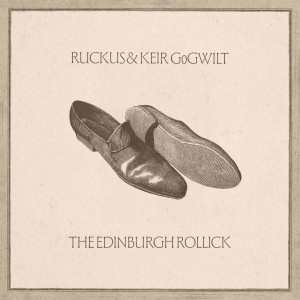 The American band Ruckus is billed as “the world’s only period-instrument rock band.” And also as “a shapeshifting collaborative baroque ensemble with a visceral and playful approach to classical music,” and that playful part is definitely born out on their sophomore album The Edinburgh Rollick. The “shapeshifting collaborative” part means that the core group of early music experts teams up with musicians with other areas of expertise to explore the intersections of European and American Baroque music with folk and other music styles. For The Edinburgh Rollick they’ve joined forces with Scottish American fiddler Keir GoGwilt, to revel in the music of Scotland’s most celebrated fiddler, Niel Gow (1727-1807). (Their previous recorded project Fly the Coop featured the world-renowned American Baroque flutist Emi Ferguson.
The American band Ruckus is billed as “the world’s only period-instrument rock band.” And also as “a shapeshifting collaborative baroque ensemble with a visceral and playful approach to classical music,” and that playful part is definitely born out on their sophomore album The Edinburgh Rollick. The “shapeshifting collaborative” part means that the core group of early music experts teams up with musicians with other areas of expertise to explore the intersections of European and American Baroque music with folk and other music styles. For The Edinburgh Rollick they’ve joined forces with Scottish American fiddler Keir GoGwilt, to revel in the music of Scotland’s most celebrated fiddler, Niel Gow (1727-1807). (Their previous recorded project Fly the Coop featured the world-renowned American Baroque flutist Emi Ferguson.
On this album the core group (also described as the baroque equivalent of a jazz rhythm section) of Paul Holmes Morton on guitar and theorbo (a bass lute with a very long neck), Elliott Figg on harpsichord and organ, Clay Zeller-Townson on bassoon and spoons, Douglas Balliett on bass and viola da gamba, and Rami El-Aasser, percussion. They’re also joined by vocalist Fiona Gillespie on several songs.
The parts of this record that most interest me are the dance sets, which puts the focus squarely on violinist GoGwilt. There are several superb tune sets here, starting immediately with the first track “The Jenny Sutton Set” (Link him Dodie/Yester House/The Fyket/The Flaggon/Miss Pensy McDonald’s/Mrs. Drummond of Logiealmonds/Jenny Sutton’s). GoGwilt’s classical training shows through in the precision of his playing, and his Scottishness is equally apparent in its rhythmic ferocity and the signature “Scotch snap” stylings. The warm, earthy tones of the instruments expertly played by the members of Ruckus are a real treat, particularly the deep, buzzing drone of the theorbo that opens this set.
There’s lots more along those lines: The absolutely rollicking “The Lord Macdonald Set” (Lord Macdonald’s/Mr. Dundass McQueen’s/Miss Mary Douglass’s/Mr. Morthland’s Reel), which winds up with some hot licks on bassoon; “The Gigg Set,” which unusually opens with a waltz, Cairngoram Mountain, followed by two jigs, Gigg and the stately Lady Charlotte Murray’s with lovely harpsichord and clattering spoons; finishing with another waltz, Marquis of Tullibard with melody played alternately on viola da gamba and bassoon; and the final track “The Jenny Nettles Set”: Jenny Nettles/Mr. Bushby Maitland’s/Dunkeld Hermitage Perth-Shire Hunt/Lady Helonora Home’s Reel. That bassoon appears throughout the sets, and as it’s a baroque bassoon it has a quite different sound than the modern instrument, very buzzy and nasal, something like a crumhorn but deeper and more resonant.
Sprinkled about between the sets are the likes of “Mrs. Ferguson’s Strathspey,” a slowish example of this form, probably set somewhere around a Highland dance tempo; the slow march “Mr. Morthland’s Favorite,” and Fiona Gillespie’s songs including the lilting “The Broome of Coudenknowes” and the dark ballad “Lord Gregory” a variation on “The Lass of Roch Royal.”
The Edinburgh Rollick is highly recommended for fans of Scottish fiddling and Celtic songs and dance music in general. The combination of GoGwilt’s modern fiddle with the period instruments and superb arrangements is consistently appealing.
(Ruckus Records, 2025)
